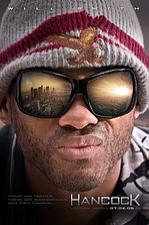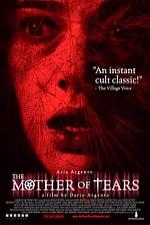
Knight at the Movies Archives
Argento's conclusion to his witch trilogy is an over the top, fabulous mess, Will Smith makes a rare misstep
30 years after receiving international acclaim for the gory, sensual and visually stunning horror film Suspiria, Italian filmmaker Dario
Argento has at last completed the third part of his supernatural horror trilogy with The Mother of Tears. The three films – part
two, Inferno, was released in 1980 – are the loosely connected stories of three ancient witches – “The Three Mothers” – who use their
black magic to rain death and destruction on the world. The films are all shot in the “giallo” style and Argento is often described as
the father of the genre. “Giallo” is the Italian word used to describe a genre of horror filmmaking that incorporates graphic,
extended murder sequences with tons of bloodletting (usually of women), stylish camerawork, baroque settings, and highly theatrical
music scores. By that definition Agento’s The Mother of Tears is the mother of giallo movies. It’s also an incomprehensible mess – at
turns campy, sexy, silly, overtly gory, and for fleeting seconds here and there, even scary. In short, a very entertaining fiasco.
The “plot” (such as it is) follows Sarah Mandy played by Asia Argento, the director’s daughter, who is most effective when she is
snarling at her many opponents. Sarah is an art student in Rome who unwittingly opens the recently discovered urn of “La Terza
Madre,” thus unleashing her tremendous evil powers. Sarah barely escapes the fate of her colleague who falls prey to one of
Argento’s most grisly murders. Aided by a series of white witches Sarah slowly learns that she alone has the power to destroy La
Terza Madre who is holed up in the catacombs under her decaying villa, drawing hordes of eager, orgy seeking witches and warlocks
to her side. Violent crimes of all kind and degradation increase in Rome (the silliest scenes in the film) along with the witch’s power
while Sarah desperately tries to piece together her own fractured past. In one memorable cat and mouse sequence, she is tracked
at the train station by both police (who want her for questioning in the brutal death of her colleague) and a persistent Japanese witch
who senses her innate power and giggles in anticipation of challenging her.
In another scene Sarah is befriended by a lesbian psychic and her lover, only to witness their excruciating, brutal deaths moments
later (after some gratuitous nudity and lovemaking of course). Surprisingly, the charge of misogyny lobbed at most giallo movies
doesn’t apply here as Argento is an equal opportunity agent of death – men, women, children, babies, even a nasty monkey all get
offed in spectacularly gross ways (for the squeamish, including myself, most of the killings are telegraphed enough in advance to
turn away). It’s just as gruesome as the torture porn of Saw and Hostel but the violence here is so audacious and so far fetched it
becomes almost comical.
Agento does offer one great suspense sequence – near the end of the film when Sarah discovers the location of the rotting villa and
having now discovered her powers brazenly walks through the home as the camera follows her in and out of the shadows in a long
tracking shot. Argento’s lighting and music (by Claudio Simonetti) are heightened further as Sarah slowly descends to the caverns
below to confront her fate. Once in the tombs the climax of the film ups the “ick factor” even higher but then offers a surprisingly
quick and benign resolve.
Though not on a par visually or aurally with Suspiria or the earlier Bird with the Crystal Plumage, The Mother of Tears has plenty to offer
both bloodthirsty audiences, style junkies, and camp horror enthusiasts.
+++++++++++++++++++++++++++++++++++++++++++++++++++++++++++++++++++++++++++++++++++++++++++++
I’m not exactly sure what to make of Hancock, Will Smith’s latest contender for box office prominence. The ads would have you
believe that the film is a special effects driven action comedy that focuses on Smith as a drunken, cranky superhero who “hilariously”
wreaks havoc every time he reluctantly steps in to fight crime and on the efforts of Jason Bateman as a down on his luck adman who
sees a public relations opportunity in rehabilitating Smith’s public reputation. That takes up about the film’s first twenty minutes,
ending with Smith volunteering to serve jail time for all the public damage he’s committed and laws he’s broken.
But then, strangely, when Smith is called back into superhero action the movie moves into much darker territory. It becomes clear
that Smith and Bateman’s wife, played by Charlize Theron, have something for each other; something pretty strong. And since we
have not been prepared for a soggy love triangle between a lonely superhero and an endearing but not very successful husband
over his luscious but cagey wife, its introduction and the odd twists in tone that follow throw one off balance.
The picture, not exactly a laugh riot to begin with, never finds its footing thereafter and though a slew of top dollar action set pieces
follow, none of them reverberate. Worse, the movie never returns to its comic roots and then abruptly conks out at 90 minutes.
Bateman and Theron do fine work under Peter Berg’s direction but Smith is left holding the bag. Audiences have come to depend on
his ability to personify flawed but heroic characters that rise to the occasion and not only take on the world, but conquer it and exult
in their ability to do so. Though Smith gets to do plenty of conquering here it’s not the sort that will leave audiences feeling
exhilarated or much of anything else for that matter. Hancock is a strange hybrid of a movie; a film that never congeals and is the
first misstep that I can recall Smith making since he refused to kiss Eric Thal on screen in Six Degrees of Separation 15 years ago.
Argento has at last completed the third part of his supernatural horror trilogy with The Mother of Tears. The three films – part
two, Inferno, was released in 1980 – are the loosely connected stories of three ancient witches – “The Three Mothers” – who use their
black magic to rain death and destruction on the world. The films are all shot in the “giallo” style and Argento is often described as
the father of the genre. “Giallo” is the Italian word used to describe a genre of horror filmmaking that incorporates graphic,
extended murder sequences with tons of bloodletting (usually of women), stylish camerawork, baroque settings, and highly theatrical
music scores. By that definition Agento’s The Mother of Tears is the mother of giallo movies. It’s also an incomprehensible mess – at
turns campy, sexy, silly, overtly gory, and for fleeting seconds here and there, even scary. In short, a very entertaining fiasco.
The “plot” (such as it is) follows Sarah Mandy played by Asia Argento, the director’s daughter, who is most effective when she is
snarling at her many opponents. Sarah is an art student in Rome who unwittingly opens the recently discovered urn of “La Terza
Madre,” thus unleashing her tremendous evil powers. Sarah barely escapes the fate of her colleague who falls prey to one of
Argento’s most grisly murders. Aided by a series of white witches Sarah slowly learns that she alone has the power to destroy La
Terza Madre who is holed up in the catacombs under her decaying villa, drawing hordes of eager, orgy seeking witches and warlocks
to her side. Violent crimes of all kind and degradation increase in Rome (the silliest scenes in the film) along with the witch’s power
while Sarah desperately tries to piece together her own fractured past. In one memorable cat and mouse sequence, she is tracked
at the train station by both police (who want her for questioning in the brutal death of her colleague) and a persistent Japanese witch
who senses her innate power and giggles in anticipation of challenging her.
In another scene Sarah is befriended by a lesbian psychic and her lover, only to witness their excruciating, brutal deaths moments
later (after some gratuitous nudity and lovemaking of course). Surprisingly, the charge of misogyny lobbed at most giallo movies
doesn’t apply here as Argento is an equal opportunity agent of death – men, women, children, babies, even a nasty monkey all get
offed in spectacularly gross ways (for the squeamish, including myself, most of the killings are telegraphed enough in advance to
turn away). It’s just as gruesome as the torture porn of Saw and Hostel but the violence here is so audacious and so far fetched it
becomes almost comical.
Agento does offer one great suspense sequence – near the end of the film when Sarah discovers the location of the rotting villa and
having now discovered her powers brazenly walks through the home as the camera follows her in and out of the shadows in a long
tracking shot. Argento’s lighting and music (by Claudio Simonetti) are heightened further as Sarah slowly descends to the caverns
below to confront her fate. Once in the tombs the climax of the film ups the “ick factor” even higher but then offers a surprisingly
quick and benign resolve.
Though not on a par visually or aurally with Suspiria or the earlier Bird with the Crystal Plumage, The Mother of Tears has plenty to offer
both bloodthirsty audiences, style junkies, and camp horror enthusiasts.
+++++++++++++++++++++++++++++++++++++++++++++++++++++++++++++++++++++++++++++++++++++++++++++
I’m not exactly sure what to make of Hancock, Will Smith’s latest contender for box office prominence. The ads would have you
believe that the film is a special effects driven action comedy that focuses on Smith as a drunken, cranky superhero who “hilariously”
wreaks havoc every time he reluctantly steps in to fight crime and on the efforts of Jason Bateman as a down on his luck adman who
sees a public relations opportunity in rehabilitating Smith’s public reputation. That takes up about the film’s first twenty minutes,
ending with Smith volunteering to serve jail time for all the public damage he’s committed and laws he’s broken.
But then, strangely, when Smith is called back into superhero action the movie moves into much darker territory. It becomes clear
that Smith and Bateman’s wife, played by Charlize Theron, have something for each other; something pretty strong. And since we
have not been prepared for a soggy love triangle between a lonely superhero and an endearing but not very successful husband
over his luscious but cagey wife, its introduction and the odd twists in tone that follow throw one off balance.
The picture, not exactly a laugh riot to begin with, never finds its footing thereafter and though a slew of top dollar action set pieces
follow, none of them reverberate. Worse, the movie never returns to its comic roots and then abruptly conks out at 90 minutes.
Bateman and Theron do fine work under Peter Berg’s direction but Smith is left holding the bag. Audiences have come to depend on
his ability to personify flawed but heroic characters that rise to the occasion and not only take on the world, but conquer it and exult
in their ability to do so. Though Smith gets to do plenty of conquering here it’s not the sort that will leave audiences feeling
exhilarated or much of anything else for that matter. Hancock is a strange hybrid of a movie; a film that never congeals and is the
first misstep that I can recall Smith making since he refused to kiss Eric Thal on screen in Six Degrees of Separation 15 years ago.
Overwhelming/Underwhelming:
The Mother of Tears-Hancock
7-2-08 Windy City Times Knight at the Movies Column
By Richard Knight, Jr.
The Mother of Tears-Hancock
7-2-08 Windy City Times Knight at the Movies Column
By Richard Knight, Jr.


